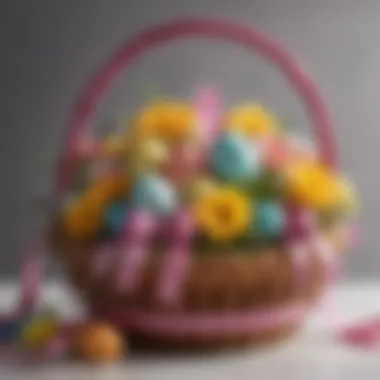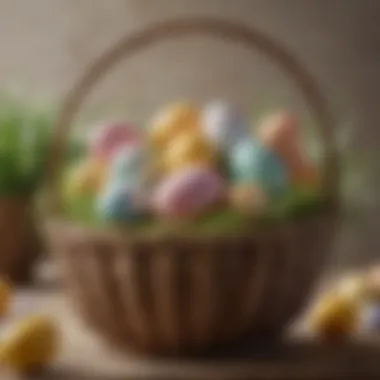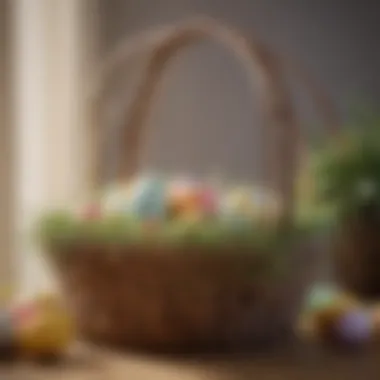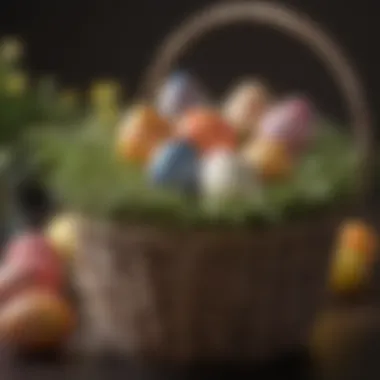Easter Basket Wrap: Elevate Your Gift Presentation


Intro
Easter is a time for celebration and joy. The tradition of giving Easter baskets filled with treats and goodies has been cherished for generations. Yet, the art of wrapping these baskets often goes overlooked. This guide aims to elevate your Easter basket wrapping skills, allowing you to create a presentation that reflects both your creativity and thoughtfulness.
In this article, we will examine various techniques and materials that enhance the aesthetic appeal of Easter baskets. Understanding the significance of wrapping will be central to our discussion—it's not merely a protective layer but an expression of love and care.
We will also explore the importance of sustainable wrapping options for those looking to make environmentally conscious choices. As you read through, you will gather insights into styles, personalization techniques, and current trends that can transform your holiday experience. The intention is to inspire creativity and encourage meaningful interactions during this festive time.
Whether you are a seasoned decorator or a novice host, this comprehensive guide is designed to offer you valuable knowledge and practical steps for crafting memorable Easter gifts.
Understanding Easter Basket Wrapping
Easter basket wrapping is not just about making gifts look appealing; it holds deeper significance. This practice relates to traditions, creativity, and thoughtfulness. Wrapping Easter baskets is a way to elevate gift presentation, enhancing the overall experience for both the giver and receiver. When considering how to present gifts, one must acknowledge the nuances involved. The way a basket is wrapped can reflect personal style and attention to detail.
The importance of understanding the techniques and materials involved in wrapping lies in their ability to create a memorable experience. Good wrapping invokes excitement and joy. It enhances the anticipation of what may be inside. This article illustrates the various techniques, styles, and materials to help you create an aesthetically pleasing and thoughtful Easter basket.
Historical Context of Easter Basket Wrapping
Historically, Easter baskets have evolved from simple containers to elaborate displays reflecting cultural and social contexts. Originally, baskets were made by hand using available materials like reeds or grasses. As time passed, commercial production brought variety in styles and designs. The practice of wrapping these baskets can be traced back to the desire to enhance their visual appeal.
The symbolism of Easter itself, associated with new beginnings and the joy of spring, is often echoed in the designs chosen for baskets. This tradition not only serves as an homage to past customs but also as a way to pass on values to future generations.
The Role of Aesthetics in Gift Presentation
Aesthetics play a crucial role in how gifts are perceived. Well-wrapped Easter baskets speak volumes about the giver’s consideration and effort. The visual impact of colors, textures, and forms can evoke emotions and set the tone for the occasion.
When you use vibrant colors, playful patterns, or subtle hues, these choices reflect personal aesthetic preferences. Furthermore, attractive wrapping can enhance the overall experience, making receiving the gift more delightful. It’s essential to remember that while the contents are important, the presentation is what can captivate one’s attention right from the start.
Cultural Variations in Easter Celebrations
Easter celebrations vary widely around the world, each culture bringing its unique traditions to the occasion. In some regions, baskets filled with chocolate eggs are common, while others may prefer artisan-made items that reflect local craftsmanship.
For instance, in Poland, Easter Monday is celebrated with splashy water fights, and baskets may be wrapped in elements that symbolize water and renewal. In contrast, in Italy, baskets might feature brightly decorated eggs as symbols of fertility and life.
Understanding these cultural contexts not only enriches the wrapping process but also enhances appreciation for the diversity of Easter celebrations globally. It could inspire one to incorporate elements from different traditions into their own baskets.
Essential Materials for Wrapping
Understanding the essential materials for wrapping Easter baskets is crucial for achieving both aesthetic appeal and functional practicality. The choice of wrapping material directly influences the visual impact and the overall presentation of the gift. It is important to consider factors such as durability, transparency, and environmental impact.
Plastic Wrap: Pros and Cons
Plastic wrap is a common choice for wrapping Easter baskets due to its flexibility and clarity. It provides a neat finish and allows for all the vibrant colors inside the basket to be visible. However, its advantages come with drawbacks. It is non-biodegradable, which poses a significant environmental concern. Additionally, plastic wrap can tear easily, which may leave the basket inadequately covered, leading to potential dust or moisture issues. It’s essential to weigh these pros and cons relative to personal values and intended presentation goals.
Cellophane: A Clear Choice
Cellophane stands as a clear favorite among wrapping materials. Unlike plastic wrap, cellophane is biodegradable, making it a more eco-friendly option. Its crisp, transparent quality enhances the display of colorful touches within the basket. Cellophane is often available in various colors and designs, which provides versatility in presentation. Its rigidity can, however, result in some challenges in terms of conforming to unconventional shapes. Keeping these characteristics in mind will help in making an informed selection while preparing Easter baskets.
Fabric Options: A Touch of Elegance
Fabric options can significantly elevate the presentation of an Easter basket. They introduce texture and depth, setting a more refined tone. Notably, tulle, muslin, and linen each bring unique qualities that can enhance the overall aesthetic.


Tulle
Tulle is a delicate, netted fabric widely embraced for its lightweight nature. Its airy appearance contributes to a soft look, ideal for festive occasions. Tulle is often used for bows or as a wrap, creating an elegant appearance. However, its sheerness can be a double-edged sword; while it allows visibility of the inner items, it can lack structural integrity if not layered thoughtfully.
Muslin
Muslin is a versatile, breathable cotton fabric that lends a rustic charm to Easter baskets. Its texture is soft and inviting, making it a beneficial choice for those seeking a cozy presentation. Muslin is flexible and can be easily tied or draped. Yet, it may not hold vibrant colors effectively without additional lining or dye, which can be a limitation for those seeking bold visuals.
Linen
Linen offers a sophisticated finish that aligns well with upscale presentations. Known for its durability and natural luster, linen adds a touch of class. The fabric adapts well to various wrapping styles and can complement a variety of decorative elements. However, it may be more expensive than other fabric options, which could be a consideration for budget-conscious consumers.
Eco-Friendly Alternatives
In recent years, the demand for eco-friendly wrapping options has surged. Many individuals are seeking sustainable materials that align with their environmental values. Some promising alternatives include recycled paper, plant-based cellophane, or even repurposed fabrics. Using these options not only contributes to environmental preservation but also adds a unique and personal touch to the wrapping process. It is essential to choose materials that reflect both the occasion's spirit and personal ethics when selecting wrapping options.
Techniques for Wrapping Easter Baskets
The technique used for wrapping Easter baskets is essential for achieving a polished and attractive presentation. Techniques can influence the overall look and feel of the basket. When executed with care, these methods not only elevate the aesthetic appeal but can also enhance the emotional resonance of the gift. Good wrapping signals thoughtfulness and care, qualities that are cherished during Easter celebrations.
The Classic Approach
The classic approach is straightforward and effective. It involves using a simple wrap that is easy to create yet impactful. Typically, cellophane or plastic wrap are common choices here. This method allows for a clear view of the items inside while still providing some protection. It emphasizes the contents and maintains an air of anticipation. The clear nature of these materials also ensures that the colors and textures of the items inside are visible, making a vibrant display.
The Bow Technique
Adding a bow can transform any wrapped basket into a work of art. This technique can involve various types of ribbons or fabric options. A well-placed bow signifies completion and adds a touch of elegance. The choice of ribbon can influence the entire theme of the basket. For a more playful approach, bright colors or patterned ribbons can be used, whereas muted or monochrome choices offer sophistication. It is a small touch that makes a significant impact on the presentation.
Layering Elements for Visual Interest
Layering elements is a technique that enhances the visual complexity of the basket. By combining different materials like tissue paper or cellophane, you can create depth and texture. This method allows for the use of various colors that complement one another. It draws the eye and creates intrigue. When layering, it is crucial to consider contrast and balance. Excessive layering may lead to chaos rather than harmony. A well-balanced basket, however, can captivate attention and convey effort.
Using Natural Elements in Wrapping
Integrating natural elements into wrapping can provide a fresh and organic feel to Easter baskets. This practice emphasizes sustainability while enhancing aesthetic appeal.
Flowers
Flowers, whether fresh or dried, can serve as a significant enhancement to an Easter basket. They add color and evoke a sense of springtime joy. The key characteristic of flowers is their natural beauty, which instantly captures attention. For example, daffodils or tulips can be ideal choices for vibrant colors. However, it is important to consider the longevity of fresh flowers as they may wilt quickly. In that sense, dried flowers can offer a lasting visual impact without the need for regular maintenance.
Foliage
Foliage provides a lush background for baskets, creating a vivid contrast with the gift items. Options like ferns or eucalyptus can add texture and depth. Foliage’s key characteristic is its variety in shapes, which can lend a unique touch. Additionally, it often complements a wide range of gifts. Nonetheless, it may also require some upkeep to maintain its fresh appearance if using live plants, which could be a con for some individuals.
Ribbons
Ribbons can tie the entire presentation together. The choice of ribbon can reflect the theme of the basket or the personality of the recipient. Its ability to be shaped into various forms allows for creativity in presentation. Ribbons are also versatile; they can be mixed with other materials for additional visual layers. The key advantage is the availability of countless styles and colors. However, they may not provide as much protection as sturdier materials might, thereby requiring careful planning on how they are used.
Using these techniques effectively can significantly enhance the beauty and personal touch of any Easter basket.
Personalization Ideas for Easter Basket Wraps


Personalizing an Easter basket is an essential aspect that enhances its overall appeal. Customization reflects care and thoughtfulness, making the recipient feel valued. In this section, we explore effective strategies for personalization that resonate with the spirit of Easter gifting.
Monogramming Techniques
Monogramming is a popular method for adding a personal touch to Easter baskets. This technique involves embroidering or printing initials on wrapping materials. Using monograms can elevate simple presentations into something special.
When selecting a monogramming technique, consider the material of your wrapping. For instance, fabric options such as linen or muslin lend themselves well to embroidery. Alternatively, cellophane can accommodate printed monograms in a sleek font. The placement of the monogram is also critical; usually, it is best positioned front and center, allowing it to be a focal point of the basket.
Custom Tags and Labels
Custom tags and labels are another effective way to personalize Easter basket wraps. They serve not just as decorative elements but also provide practical information, such as the recipient's name or a heartfelt message. Utilizing tags enhances the overall presentation of the basket and adds a distinct touch.
You can create tags from various materials like cardstock, recycled paper, or even fabric. Handwritten tags often evoke a sense of warmth. Choosing colors that harmonize with your wrapping material enhances visual coherence. Consider attaching the tags with ribbons or twine for an attractive finish that aligns with the overall theme of the basket.
Incorporating Handmade Elements
Incorporating handmade elements into your Easter basket wrap can significantly boost its uniqueness. These elements can range from handmade decorations to intricately crafted items that reflect the recipient's interests.
For instance, you might create small handcrafted ornaments tied to the basket's theme. Or using dried flowers and natural elements adds a rustic charm. The key consideration is to ensure these handmade features complement the basket's overall aesthetic without overwhelming it.
Emphasizing craftsmanship not only enhances the basket's appeal but also fosters a connection between the giver and the recipient. This allows you to express creativity while maintaining thoughtfulness in your gift presentation.
Personalization transforms a simple Easter gift into a treasured memory.
By exploring various personalization ideas, your Easter baskets can reflect individuality and significance. Utilizing techniques such as monogramming, custom tags, and incorporating handmade details offers limitless opportunities to make your Easter basket truly distinctive.
Innovative Wrapping Styles
Innovative wrapping styles are significant in transforming the mundane task of wrapping Easter baskets into an artistic expression. This article explores how these styles not only enhance visual appeal but also provide a unique experience when giving gifts. They allow the gift giver to show thoughtfulness and creativity, reflecting personal taste and seasonal themes. When selecting an innovative wrapping style, one must consider the preferences of the recipient, the occasion, and the overall aesthetic of the gift.
Minimalist Aesthetics
Minimalism is a popular choice for Easter basket wrapping, characterized by clean lines, limited color palettes, and an emphasis on simplicity. This style focuses on decluttering the presentation, often utilizing earthy tones or soft pastels to convey elegance without overwhelming the senses.
The benefits of minimalist aesthetics include:
- Focus on Key Elements: By keeping components simple, each element stands out.
- Timeless Appeal: Minimalist styles have a classic nature, making them suitable for various tastes.
- Sustainability: Often involves the use of fewer materials, aligning with eco-conscious practices.
Consider using kraft paper or plain linen to wrap the basket, adding a small, subtle natural element, like a single flower or a simple twine bow, for an understated yet sophisticated look.
Whimsical Approaches
Whimsical wrapping styles embrace creativity and playfulness, offering a delightful contrast to the more traditional methods. This approach often involves bright colors, fun patterns, or playful shapes. It allows the gifter to inject personality and joy into their presentation.
Some key considerations include:
- Expressive Designs: Striking designs can reflect the personality of the gift giver, turning the act of wrapping into a form of self-expression.
- Festive Themes: Whimsical wraps can effectively capture the spirit of Easter, incorporating bunny motifs, pastel colors, or even egg designs.
- Engagement Factor: A playful wrapping can create excitement and anticipation for the recipient, enhancing the overall gift-giving experience.
You might consider using patterned cellophane or vibrant fabric to wrap the basket, complemented by colorful ribbons or decorative tags. Adding small toys or festive decorations can contribute to the whimsical feel.
Rustic Charm in Presentation


Rustic charm in presentation evokes a sense of warmth and simplicity. This style draws inspiration from nature and embraces materials that are textured and organic. It emphasizes a connection to the outdoors and often utilizes colors and textures found in natural settings.
This approach is beneficial for:
- Creating Emotion: Rustic styles can evoke nostalgia and comfort, making the gift feel more personal.
- Versatile Elements: Items like burlap, reclaimed wood, or dried flowers can be combined in countless ways to present a different feel.
- Eco-Friendly Appeal: Many rustic materials are sustainable and biodegradable, aligning with modern values of environmental consciousness.
For an Easter basket, consider wrapping it in burlap with a jute twine bow. You can add natural embellishments such as fresh flowers, pine cones, or small branches to complete the look.
"Innovative wrapping styles are not just about aesthetics; they can create a connection between giver and receiver."
By thoughtfully exploring various wrapping styles, you can elevate the presentation of Easter baskets while adding a personal touch that resonates with the recipient. Emphasizing innovation in your wrapping practices will surely create memorable holiday experiences.
Sustainable Practices in Easter Basket Wrapping
In recent years, there has been a significant shift toward sustainability. This is essential in all areas of life, including holiday celebrations. For many, easter represents a time of joy and giving, but it is also an opportunity to reflect on the impact of our choices. Using sustainable practices in wrapping Easter baskets can reduce waste while maintaining the beauty and enjoyment of the occasion. From choosing recyclable materials to crafting our own wrapping, there are many paths to a more eco-friendly approach.
Choosing Recyclable Materials
Selecting recyclable materials is an important step toward sustainability. Traditional wrapping materials like plastic wrap and non-recyclable cellophane can contribute to landfill waste. Instead, consider paper products that are fully recyclable. Wrapping paper created from recycled fibers or sustainable sources can serve both aesthetic and environmentally friendly purposes.
Furthermore, you should check for recycling symbols on products. Many local recyclers will accept specific materials, making it easier to keep waste to a minimum. This small adjustment in wrapping choices can lead to a more significant cumulative impact on our environment.
Reusable Elements in Wrapping
Integrating reusable elements into Easter basket wrapping takes sustainability a step further. Instead of disposable wraps, you can opt for materials that can be used again. For instance, fabric wraps like Furoshiki, a traditional Japanese technique, allow for creative folds and knots that can be reused year after year.
Additionally, ribbon or twine can add a decorative touch that doesn’t have to be tossed away after use. Skip single-use items and focus on long-lasting materials. Over time, this transition not only saves money but also reduces waste significantly.
Crafting Your Own Wrapping Materials
A unique way to personalize Easter baskets while promoting sustainability is by crafting your own wrapping materials. This allows for a connection to the art of gift presentation and embeds a sense of creativity into your Easter traditions. Old newspapers, magazines, or fabric scraps can be transformed into beautiful wraps or bags.
In addition to being eco-friendly, this approach provides an opportunity for personalization. Use simple craft supplies like stamps or markers to decorate your creations. Alternatively, consider planting seeds into your wraps—once the gift has been unwrapped, recipients can plant the wrapping, gaining an additional benefit.
"The smallest act of caring for another is like a drop of water. It will make ripples throughout the entire pond."
– J. B.
Finale
Easter basket wrapping is not merely about enclosing gifts with colorful materials; it encompasses a range of considerations that enhance the overall gift-giving experience. The process affects not just the aesthetics of the presentation but also the emotional response of the recipient. A well-wrapped basket can evoke joy and excitement, transforming a simple gift into a memorable experience.
The significance of wrapping extends to sustainability and personalization. With the increasing awareness of environmental issues, choosing eco-friendly materials is becoming essential. This practice reduces waste while still allowing for creativity in presentation. Personalization techniques, such as monogramming or handmade tags, not only beautify the basket but also imbue it with a more thoughtful touch, showing the giver's care and attention.
The benefits of mastering Easter basket wrapping are numerous. It allows individuals to express creativity, encourages engagement in holiday traditions, and enhances relationships through the thoughtfulness of presentation. A well-executed wrapping can communicate sentiments of love and joy that complement the gifts within the basket.
Final Thoughts on Easter Basket Wrapping
As we revisit the significance of wrapping Easter baskets, it is crucial to acknowledge that this act has evolved over time. While its historical roots may be tied to tangible elements of the celebration, its contemporary relevance lies in its ability to cater to individual tastes and values. By integrating traditional methods with modern eco-friendly options, anyone can create an Easter basket that reflects personal style and consciousness.
The balance between aesthetics and functionality should guide your wrapping choices. Ensure that materials selected not only look appealing but also serve a practical purpose, such as protecting the contents of the basket.
Encouraging Creative Expression in Gift Presentation
Encouraging creativity in wrapping presents allows for personal connections to be made and often results in a greater appreciation for the gift itself. When individuals take the time to thoughtfully wrap gifts, it often leads to an enhanced emotional response from the recipient. This process can highlight the thoughtfulness behind each present.
To promote this creative expression, consider a few strategies:
- Allow your children or family members to partake in the wrapping process. This can foster communication and collaboration among family members.
- Explore various wrapping materials beyond the usual plastic and paper options. Items like fabric or natural elements can create unique visual experiences.
- Engage in themed wrapping based on the recipient's interests or hobbies. This can bridge the connection between the gift and the recipient.
Through these methods, individuals can find new joy in wrapping gifts. The focus shifts from a chore to an art form, where every basket transforms into a canvas of expression.



